 Subscribe to this blog
Subscribe to this blog

Connie Haden was a magician, creator, machinist and Magic dealer based out of New York. Here is the actual address that he would advertise in the magazines:
257 90th Street
Brooklyn 9, New York
In the 1940s Connie created first expanded shell coin gimmick.

He also created the first double shell coin which he would use to fool many magicians at conventions. This was the predecessor to the "triple threat" that was revolutionized by Todd Lassen, and copied by many.
John Braun had this to say about Connie Haden's work in the August 1968 issue of The Linking Ring:
"An Okito Coin Box made up in a size to take the small U.S. penny, there are many routines of coin tricks using pennies.
(see Modern Coin Magic. Magic Inc. will be glad to hear from you)
and this penny sized Okito Box is about the cutest thing I've seen in a long time. Connie Haden has it.
Connie also fooled "the bejabbers" out of me with a Double Shell English Penny - $13 for three pieces - all "gaffed' - you get a copper-silver coin, one double shell and one cutdown and re-milled silver coin, and you are limited only by your own ingenuity and imagination, for I saw some unbelievable magic with the outfit."
Connie created a very unique & USEFUL version of the classic Dime & Penny trick. Connie's version has two inserts instead of the customary one. One is locking, and the other is loose, so that it may be shown as a complete penny. It can be easily un nested to be shown as a penny and a dime.

Connie made what was considered by far the best Nail Writers of the time. Released multiple versions.
Connie Haden's innovative way of making nail writers is still being used today by Viking Magic
The Writers are made using the original Connie Haden dies. Viking Magic owns the rights to the Connie Haden Writers. They can be purchased here:
https://vikingmagic.com/products/swami-band-listo-writer

"Five different types have been made by Conrad H. Haden, all intended by him for use on the thumb but all adaptable for the forefinger, if desired. His regular "Band Type" is a segment of a ring or band of metal which goes around the ball of the thumb with the open or cut-out part of the band on top of the thumb.
Haden's original Band Type has since been discontinued, being replaced by his "Improved Band Type" which is the same as the one just described except that the lead holder is on an arm that projects forward from the main part of the band, thus bringing the lead out farther towards the tip of the thumb than in the regular "Band Type." Both of these models might be described as skeleton thumb tips.
Persons having either very long or very short thumb nails, should use band type writers.
The tiniest one made by Mr. Haden is called the "Clip Type," and, as its name implies, it clips onto a thumb nail of average length. Many performers find it rather insecure, however others seem to have no difficulty at all in its use. His other model is called the "Under-nail Type" and is of the same general construction as the "Clip" with the addition of a little half-moon shaped bit of metal that fits under nail, making it steadier in use."

Connie Haden Created the classic coin effect "The Silver & Two Copper Transposition" which was described in Bobo's Modern Coin Magic
This was a great innovation in coin magic, allowing two different sized copper foreign coins to visually transform into a silver half dollar. Many people don't realize the original version that he machined used not only two different foreign coins, but two different SIZED coins as you can see in the photos.

This was the inspiration for Pressley Guitar's Copper Silver Brass which was later stolen by Johnson Products
Connie constructed gimmicks and apparatus for Richard Himber. Here is one example from a recent Potter auction.

(One of the scarcer Himber props, the rings were made for him by Brooklyn-based craftsman Connie Haden. When advertised in the pages of Genii magazine, the price was listed as "on application.")
Here is a photo of a set of cups machined & produced by Connie Haden.

Connie Haden Coin Wand

Connie was the first to machine/produce what is now known as the Chinatown coin gimmick. Created by John Benzais and manufactured by Haden. Connie also machined and produced the "Talking Stack", another John Benzais creation. This was a version of the classic Cap & Pence coin stack that allowed for the stack to appear as loose coins and "talk" which added to the auditory illusion of the coins being loose.
In the early 2000's Roger Klause released the coin effect "WHISPER" which was actually an un-authorized version of Bob White's routine of the classic Nate Leipzig handling of the Cap & Pence. This is the version where the stack of coins penetrates the spectators hand.
Turns out the entire routine/handling and construction of the gimmick...was all pre-dated by Connie Haden. The routine can be found in The Linking Ring Vol. 49, November 1969 issue. It is titled "Stack of Quarters Improved".

Traffic Lite 1960
TRAFFIC LITE
By Conrad Haden
A metal checker or counter is introduced. It is first shown to be yellow. Then it turns green, then red, and can be immediately passed out for examination. This is a beautifully made piece of precision apparatus and is made with the craftsmanship which marks all Haden products. No pulls, no difficult sleights, no magnets or wax.
All self-contained. The patter is to the effect that the colored checker represents a traffic light and the spectator is being tested for his color.

HADEN'S PEN-SILLY
A precision machined (By C. H. Haden) piece of apparatus. You write a number with this pencil and then hand to spectator and it falls apart. When you take it back you immediately make whole and continue to write with it. Spectator gets the SURPRISE OF HIS LIFE.
The Mental Pencil, made by C. H.
Haden and sold by Kanter, Holden, Robson, etc., is an innocent-looking lead pencil with a pocket clip. It will supply the "necessary" for doing "Sleight of Foot," and aid in performing several other card discoveries that just can't be done otherwise. Easy to use, and good. Complete instructions and a generous supply of the magic powder.
Haden's De Luxe Writer
made by C. H. Haden and sold by all dealers, is an improved thumb-writer which writes a large and easily read message--one that looks like it had been written with a pencil. Special leads are used, and you get a generous supply, as well as complete instructions for the use of this little gimmick in mental effects.
Glass Thru Hat

Gimmick for writing with chalk on a slate, similar to manner in which you would use a thumb-writer for secretly writing on cards, envelopes, or the like. You can write thick chalk lines
Spirit Writer
put out by Conrad Haden. All dealers. Probably inspired by the famous sugar lump message trick, this clever gimmick enables you to impress upon a spectator the name of a card he se-lected, and which the "spirits" failed to write upon a blank business card.
The impression you make is on the spectator's hand, and I can assure you that the whole thing is "pain-less." Spectator won't even be aware of what you're up to. Printed in-structions, well illustrated and gim-mick. Good Value.
Snap Rope Gimmick
In the 1940s he released "Haden's Snap Rope Gimmick" which was a well machine, gimmick enabling you to perform a beautiful, cut and restored rope.






January 23
6:30pm
Fort Lauderdale Magic Club
Tamarac Community Center
8601 West Commercial Blvd.
Fort Lauderdale, FL
January 28
7pm
Sarasota Magic Club
IHOP 7pm
4400 S. Tamiami Trail
Sarasota, FL
Howdy Folks!!!
This post includes tips for my effect EYE OPENER
Like I said, nothing fancy just an eyeball on a reel.
The instructions are literally "bend over and pretend to put the eyeball in your head and let go of it"
I fasten it in inside my jacket on my inner left breast pocket.
The line runs from the inside of my jacket to my left hand. The left hand holds the eyeball by the bottom and the hand naturally hides the plastic connection.
I just let go of the eye as I bend my head over. That's it.
The bigger motion of bending your head down and leaning forward covers the small movement of releasing the eyeball by the left hand.
Let me know if you have any questions or there is any confusion :-)
Another tip would be don’t hold the eye ball as the snap can come unsnapped, but rather show the eyeball holding by the plastic snap piece.
If you have trouble with the eyeball coming un-snapped try releasing it from a different grip point as already mentioned. If you still have trouble you can always permanently glue the snap and the eyeball together. But I prefer to have it interchangeable.
*****Finally here is a write up of my full routine:
Copper Silver Brass Routine 2018
You will be using the Copper Silver Brass gaff created by Pressley Guitar. This routine was inspired by a routine of Yuji Wada.
I use only the nested gimmick itself and one normal half dollar...and discard the extra coins. They will not be needed.
To begin the routine I start with the normal American Half Dollar hidden underneath the coin purse on the table. Alternately you can have the coin hidden underneath the cardbox or any other item.
The nested gaff is in your right hand finger palm with the silver side against the fingers. This way when you push the coin out at the fingertips they will see the silver side and it will look like you have just produced a half dollar.
I usually produce this first coin by lighting a piece of flash paper and simply pushing the nested gaff to my fingertips as the flash paper burns.
This is a very visual production and will get everyone's attention.
I know perform and retention vanish apparently placing the silver coin into my left hand but retaining in the right-hand.
I reach to my left elbow and say "if I am quick I can catch the coin as it flies up my sleeve!".
Once I produce the silver coin again I show it to the audience and then display it on my left hand in an open fingerpalm position, silver side up.
I now perform a "fake take". Apparently picking up the silver gaff from the left hand but in reality leaving it there
The right hand and fingers are held as if they are holding the coin and pretend to run it in your left elbow. Your left hand then reaches over to your right elbow and produces the coin, apparently plucking it from the right elbow and showing it in the left hand open fingerpalm position.
This entire sequence is mainly a psychological ploy to subtlety imply that the silver half dollar is "normal" without saying so. This quick "one coin flurry" does a good job at making the half seem normal.
Now you will perform a very suspicious move trying to confuse them.
"If I do a sneaky move like this you're not sure if the coin is in my left hand or my right hand?",
Suiting actions towards you now bring your hands together and make it look like you have tossed the coin from your left hand into the right. In reality you just toss the insert but retain the shell.
It's easy. Just rotate your left hand palm down and the insert will fall out of the shell, if you slightly curl your left fingers the shell will be retained in left fingerpalm.
As soon as the insert falls into your right hand, close your hand so they can't see what's there.
You can now immediately open your right and left hands showing the two foreign coins have appeared and slowly lift the purse on the table to show that the half dollar has vanished and jumped underneath the coin purse!
***Make sure you are showing the copper side of the copper silver insert in the right hand, and that you are showing the top of the shell in the left-hand and not the underside :-)
This is an extremely visual moment!!
Phase Two
At this point display the coins on the open left hand and you will perform the standard CSB move.
The insert is on the bottom, then the shell, then the real half dollar on top of all. The left hand closes into a fist which causes the gaff to nest. Your right hand reaches into your left fist and extracts the nested gaff displaying the silver side so it appears to be the single silver half dollar.
Using the table, or someone outstretched hand, I know pin the gaff under my closed left fist so that the gaff is pinned between my fist and the table perpendicularly.
Now for the cool part. All you have to do is literally open your left hand which causes the gaff to fall forward un-nesting itself and when you open your left hand they will see the half dollar. It's a very beautiful and visual instant transposition.
i show this in the video clip below...
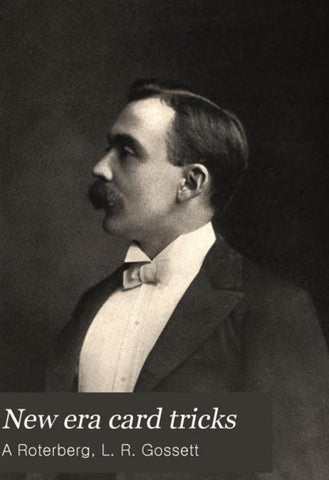
New Era Card Tricks by August Roterberg
New Era Card Tricks was written specifically for magicians by Chicago magic dealer August Roterberg, unlike prior magic books which were published and written for the public.
New Era Card Tricks contains a number of mechanical card effects and gaffs reproduced from the German works of F. W. Conradi. The book introduced the term "Color Change" and gave an early explanation of the Double Lift. It was also the first book to provide a description of the Back Palm. It may have been an influence or inspiration for S.W. Erdnase when writing Expert at the Card Table since some of the sleights are identical or provided inspiration for Erdnase.
In 1897 it sold for two dollars. Original copies have gone for $250 or more on auction sites.
Lucky for us it was reprinted just a few years ago and is available at a very reasonable cost thanks to Stephen Minch and Byron Walker.
It is definitely one of my favorite card magic books. It's full of popular card magic from the turn of the century and includes some amazingly strong magic,
Just because it's old doesn't mean it is not full of cutting edge magic.
Probably the first version of the Haunted Pack ever published. This is a classic of magic popularized by Al Baker, Eugene Burger and others.
Look up August's "The Hypnotized Card" inside this book for a magical version where the deck cuts all by itself exactly where the selected card lies. Here's a tip: instead of using a magic wand use a pen and a pad of paper. You'll thank me later ;).
Another favorite effect of mine from this book is an extremely magical trick where a letter that you received in the mail is displayed and when you toss the letter in the air it turns into the selected card. This is great visual magic at its best. Another hidden gem called "the envelope card" and is found on page 258.
Here's one more:
"Improved cards read behind the back". This effect could be used to close your show!!! A deck is thoroughly shuffled by audience members and the performer has his back turned and is blindfolded.
You could even have a bag over your head because you genuinely cannot see. Even though the cards of been shuffled and you are blindfolded you are now able to call off the cards in order as they are dealt one at a time until you have named every card!!!
Track yourself down a copy and you'll be glad you did. Enjoy!!!
Kranzilla :-)

Joe Karson (1912-1980) was owner of the mail order business "Karson Xclusives", a had magic shop in Springfield, Massachusetts, and was the inventor of the Zombie floating ball illusion.
Yup the dude that invented the Zombie! That's quite a classic. And what a great illusion when performed well. We have Joe to thank for that.
He was playing with the old impromptu trick where you interlace your fingers and pretend to float a match behind them. That inspired the Zombie.
Joe patented the Zombie illusion in 1940.
I'd like to bring you your attention to a lesser known trick of his. A great piece of card magic called "the worlds fastest card trick".
This trick is something that Joe was known for but forgotten by modern day magicians.
I searched on Ask Alexander and found many mentions of Joe performing at conventions around the US over 50 years ago. Many times the highlight of the performance was his rendition of "the world's fastest card trick".
The effect is a lesson in performance and timing. If you learn how to effectively perform this trick for an audience you will be on your way to being a great entertainer with a deck of cards.
The trick has several "false starts", creating a fun and playful comedic tempo. Joe has built into the routine several hilarious moments, especially after several attempts to find the card.....the spectator admits "I forgot my card", for a huge laugh!!!
Not too much has been written about Joe's original effect. But there is a brilliant book titled: Ken de Courcy discusses "the worlds fastest card trick" 
I highly recommend you track it down
Ken discusses several ways to handle the ending of the effect and teaches some additional gags that add some great comedy to the already hilarious routine.
The routine can be done at the drop of a hat using any borrow deck of cards. Uses very little sleight of hand, can be performed for a huge audience and plays well even on stage. What more could you ask for?
The original Joe Karson "the world's fastest card trick" is worth tracking down. A quick search online should find it for about $2.
Have fun hunting!!!!
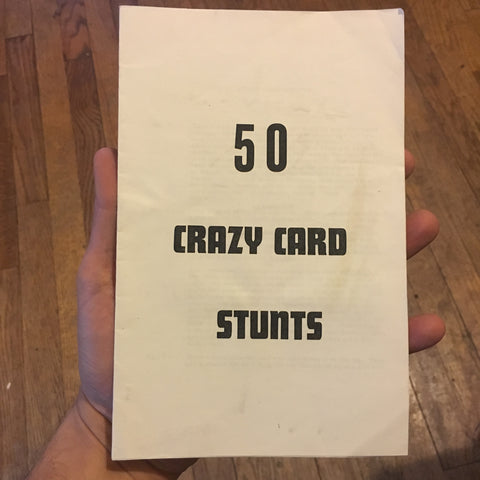
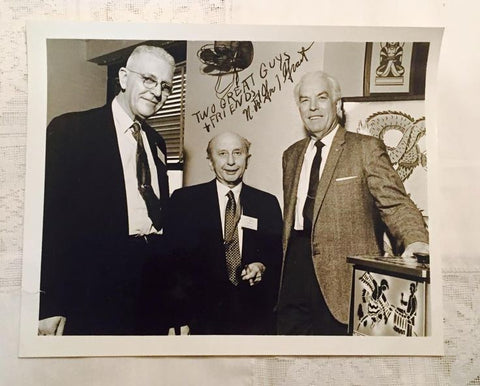
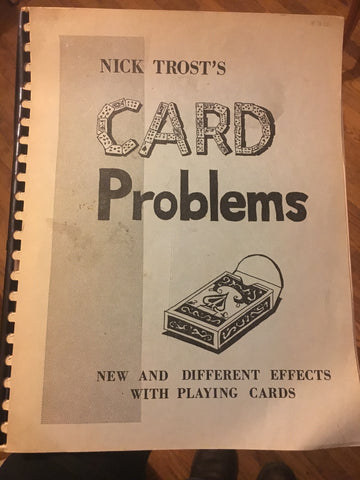
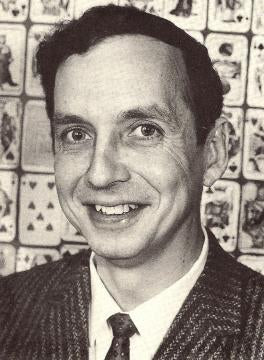
Nick Trost
Nick Trost has created some amazing card magic. He has published dozens of books on card magic as well as many popular packet tricks.
Trost wrote and edited a column on card magic in The New Tops from May 1961 until December 1994.
He had a Hocus Pocus Parade in Linking Ring, Vol. 34, No. 12 (February 1955) and received the award for Originality of a Card Effect at the IBMConvention in Pittsburgh, PA that same year.
He may be remembered for one of his most notable creations the "eight card brainwave".
This is really a brilliant creation. Clever construction combined with Marlo's "olram display" move sequence.
In this classic effect you show eight cards and the spectator can think of, or name anyone. It's a free choice. Then you cleanly show that every single card is blue except for the one they chose which has a red back.
I have published a version of this trick using 8 credit cards. They choose any one. And then you show that all the cards are stamped with the words "declined" except for the one they chose.
In the 1970s and 80s and even the early part of the 90s "packet tricks" were very popular amongst magic shops and dealers.
(A packet trick is basically a card trick that just uses a small packet of 4 to 10 cards. Often times using a gaff or specially printed cards)
This style of card trick was highly marketed by magic shops and mail order magic stores.
When I worked at the Cuckoo's Nest magic shop during college in Pittsburgh I would often demonstrate his packet Trick "fly circus", it was a lot of fun to perform and very off beat.
You can find a list of many of his books and packet trick creations at Magicpedia. Interested students should look up all of his material but a good place to start is The Card Magic Of Nick Trost.
Today I would like to bring your attention to a lesser known booklet of Nick's.
'CARD Problems' is the name of the booklet and it contains 12 impromptu card routines.
Here are a couple of my favorites:
"Two card transposition"
In Nick's handling he uses an odd backed card so it's very easy to follow the transposition because the cards have different backs. This is a transposition with a kicker ending. And is all accomplished with nothing more than a double lift
"cards in pocket mystery"
This is my favorite trick in the book. While you're back is turned and you are on the other side of the room......you have the spectator shuffle about half the deck. After some simple instructions they select a card and you have them divide the cards they have shuffled into colors placing them in different pockets.
You are NOW able to tell them how many red cards are in their pocket, how many black cards are in the other pocket. And you are able to tell them the card they are thinking of!
And it's self working!!!!
There is another hidden gem in this book. A very strong packet trick where you clearly show the four Queens and the four Kings. The Kings are dropped on top of the Queens and immediately you can cleanly deal through the cards showing that they have all paired up instantly!!!!!
Honestly if you just search the Internet for anything by Nick Trost. Just get it. You'll be happy you did. Many of those booklets are out of print and hard to find but it will be worth the search. And luckily most of his material has been reprinted in the recent release of his "subtle card miracle" series.
Enjoy!!!!